To the uninitiated, eating a cactus sounds a bit dicey—until you taste the prickly pear. The flavors are bright yet familiar—something like a tart strawberry combined with sweet watermelon, all with a hint of bubblegum.
It’s no wonder that Mexican cooking has infinite uses for it—soups, salads, side dishes, jams and jellies, candies, drinks, and more. Not surprisingly—because, why else are we here?—several breweries are putting those vivid flavors to work.
Some background: Nopal is its Mexican-Spanish name, derived from its name in Nahuatl, the Aztec language. Other common names include tuna fruit, cactus fruit, and Indian fig. The Latin genus is Opuntia, named for the ancient Greek city of Opus—because, according to Theophrastus, the city had an edible plant there that could be cultivated by planting its leaves.
If you’d like to taste it for yourself, a Mexican grocery is a good place to start—although prickly pear–flavored drinks, cocktail syrups, and other products are increasingly finding their way even into mainstream American supermarkets. Of course, you can also order it online.
However, unless you live pretty far north, there’s a decent chance you can find or even grow it locally. They’re native to the Americas but have been transplanted around the world, from northern Africa to Australia to Illinois, typically prospering anywhere with dry summers and mild winters. Like other cacti, prickly pear needs very little water, so it’s viewed as highly sustainable.
If you find some, peel carefully—besides the big and more obvious spines, there are smaller ones called glochids that like to lodge themselves in your mouth. Apparently, toasting the fruit over a fire will help pop those things out, as will soaking them in water.
Brewing with Prickly Pear
A few high-profile breweries have made beers flavored with prickly pear, including Spoetzl’s Shiner Prickly Pear lager and Founders Más Agave Clásica Prickly Pear. Even Anheuser-Busch got into the prickly-pear game with a flavored version of Michelob Ultra—so clearly there are some who view its flavors as having wide appeal.
For advice about how to brew with it, we reached out to Ayla Kapahi, head brewer and director of production at Borderlands Brewing in Tucson, Arizona. One of their core beers is Prickly Pear Wheat.
Kapahi says she wasn’t familiar with real prickly pear until she moved to Arizona from northern California 10 years ago. Before that, she’d tasted it in the occasional flavored margarita, but the “mass-produced prickly-pear syrups frequently used in margaritas actually have little to no prickly-pear fruit at all,” she says, because they’re “masked by high-fructose corn syrup and artificial dyes. I think that’s the flavor most Americans are used to tasting when they order a prickly-pear drink.”
She says she was shocked the first time she tasted the real thing in Tucson. “I didn’t know it had so many edible, tiny black seeds and explosive flavors of dragon fruit and watermelon,” she says. “I was instantly intrigued by such a flavorful fruit that grew naturally on a cactus, in the desert. How could a fruit so sweet and juicy naturally survive in such a harsh environment? That’s when I set out to understand what I call ‘the hidden secrets of prickly-pear fruit.’”
Kapahi and the Borderlands team enjoy using local and Mexican-inspired flavors when they can, including locally grown white Sonora wheat and Mexican vanilla, as well as beers inspired by micheladas and horchata. So, a beer made from nopales fits right in. “The fruit and cactus have been harvested and prepared by both Mexican and Native communities in our area for thousands of years,” Kapahi says. “We want our beer to honor and respect these communities, their harvest process, and flavors.”
While prickly pear’s flavors are fruity, they’re not always intense. “Prickly-pear fruit can be subtle, but [it’s] noticeable on a beer’s nose and on your palate,” she says. “We brew with this in mind by using fruity yet light and clean yeast to accentuate that. The same goes for hop additions. Try using Hüll Melon or Mandarina Bavaria hops during bittering and late additions to bring [out] those flavors.”
Kapahi says that they find the fruit works best in gose-style tart beers and American wheat ales. “You can, of course, add it to hoppier beer styles,” she says, “but prickly pear fruit flavors and aromas are easily masked by bitterness and high alpha-acid dry-hop additions. If you want to go hoppy, stick to pale ales or session IPAs.”
When Kapahi first started brewing with prickly pear about six years ago on a two-barrel system, they were processing all the fruit themselves, using various tricks to avoid and remove the spines. “It’s a very labor-intensive process,” she says.
Today, at Borderlands, they use locally harvested and processed juice—or purée, considering it still has a lot of pulp in it—sourced from locally based Arizona Cactus Ranch. At the brewery, they filter it again; Kapahi says it takes about two hours to strain six gallons (23 liters) of juice. They use all six gallons for a 20-barrel (23.5 hectoliter) batch of beer, adding it when transferring to the brite tank after fermentation is complete. That may not sound like much, but Kapahi says the juice they get is fresh and potent, and it’s plenty to get the flavor they want.
“Best results come from using high-quality ingredients—especially for prickly-pear fruit,” she says. “Try using a puree or high-quality juice, without added sugar or water. Even better, harvest and process it yourself if you have the opportunity to do so.”

